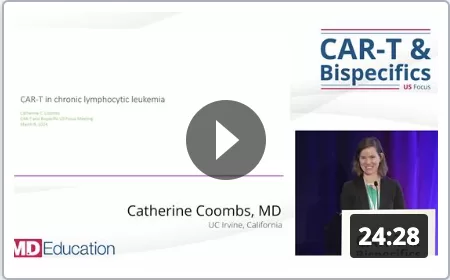Introduction
During a comprehensive presentation by Dr. Catherine Coombs at UC Irvine, insights into the unique challenges and opportunities of using CAR T-cell therapies in Chronic Lymphocytic Leukemia (CLL) were discussed. Despite CLL being a malignancy with numerous effective treatment options, CAR T-cell therapy has been relatively slow to gain approval. This detailed exploration highlights the potential and hurdles of integrating CAR T into CLL management, including a review of Lysacel and other significant treatments.
The State of CAR T in CLL
Challenges in CLL
Dr. Coombs pointed out that CLL is characterized by immune dysfunction, which can impair the efficacy of T-cell therapies. This includes T-cell exhaustion, altered CD4/CD8 ratios, and an increase in regulatory T cells (Tregs). These issues become exacerbated with disease progression and after multiple lines of therapy, impacting the potential success of CAR T treatments in CLL patients.
Promising Early Results with CAR T
Despite the challenges, early trials like those involving Kymriah and Tisacel have shown promise. These trials reported response rates around 57% with some patients achieving sustained remission for a decade, indicating a profound potential for long-term benefit in a subset of patients.
Lysacel: A Closer Look at Recent Advances
Trial Overview and Patient Demographics
Dr. Coombs focused on Lysacel, particularly the Phase 1/2 Transcend CLL004 trial. This trial targeted a subset of patients with high unmet needs—those double refractory to covalent BTK inhibitors and Venetoclax. The median age of participants was in the mid-60s, indicating a selection of relatively younger CLL patients for CAR T therapy trials, who typically had multiple prior lines of therapy.
Efficacy and Response Rates
The primary endpoint of CR/CRI rate showed promising results, with 20% achieving CR, which is significant considering the refractory nature of the patient population. The overall response rate was 44%, with a high rate of undetectable MRD at 64%, showcasing the robust activity of Lysacel.
Implications for Future Treatment Approaches
CAR T Without Transplant
A critical question discussed was whether CAR T therapy could obviate the need for transplant in CLL patients. Data from trials like Eliana in pediatric and young adult patients suggest that prolonged B-cell aplasia, an indicator of CAR T persistence, could allow some patients to avoid subsequent transplants. This aspect is crucial as it relates directly to patient quality of life and long-term management strategies.
Managing High Tumor Burden
High tumor burden has been identified as a significant factor affecting outcomes. Patients with high disease burden not only show poorer responses but also higher incidences of complications like cytokine release syndrome (CRS). Pre-treatment to reduce tumor load before administering CAR T has been suggested as a strategy to improve outcomes and reduce adverse effects.
Conclusions and Future Directions
Integrating CAR T with Other Therapies
The integration of CAR T with other modalities, including newer agents like bispecific antibodies and ongoing trials in first-line settings, represents the frontier of CLL treatment. As Dr. Coombs highlighted, understanding how to sequence these powerful therapies—balancing efficacy with patient-specific factors like age and prior treatments—will be critical.
Looking Ahead
The potential FDA approval of treatments like Lysacel marks an exciting era for CLL treatment. However, the challenge remains to define the most appropriate patient populations for these therapies and to manage the complex logistics and potential toxicities associated with them.
Dr. Coombs’ presentation underscores the nuanced, yet optimistic landscape of CAR T therapy in CLL. It highlights the need for continued research, particularly in optimizing treatment sequences and understanding long-term outcomes, to fully harness the transformative potential of this therapy in chronic lymphocytic leukemia.
Resources:

